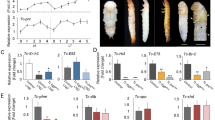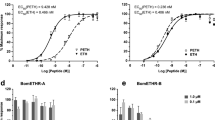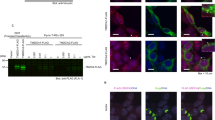Abstract
Neurotrophin receptors corresponding to vertebrate Trk, p75NTR or Sortilin have not been identified in Drosophila, thus it is unknown how neurotrophism may be implemented in insects. Two Drosophila neurotrophins, DNT1 and DNT2, have nervous system functions, but their receptors are unknown. The Toll receptor superfamily has ancient evolutionary origins and a universal function in innate immunity. Here we show that Toll paralogs unrelated to the mammalian neurotrophin receptors function as neurotrophin receptors in fruit flies. Toll-6 and Toll-7 are expressed in the CNS throughout development and regulate locomotion, motor axon targeting and neuronal survival. DNT1 (also known as NT1 and spz2) and DNT2 (also known as NT2 and spz5) interact genetically with Toll-6 and Toll-7, and DNT1 and DNT2 bind to Toll-6 and Toll-7 promiscuously and are distributed in vivo in domains complementary to or overlapping with those of Toll-6 and Toll-7. We conclude that in fruit flies, Tolls are not only involved in development and immunity but also in neurotrophism, revealing an unforeseen relationship between the neurotrophin and Toll protein families.
This is a preview of subscription content, access via your institution
Access options
Subscribe to this journal
Receive 12 print issues and online access
$209.00 per year
only $17.42 per issue
Buy this article
- Purchase on Springer Link
- Instant access to full article PDF
Prices may be subject to local taxes which are calculated during checkout







Similar content being viewed by others
References
Leulier, F. & Lemaitre, B. Toll-like receptors—taking an evolutionary approach. Nat. Rev. Genet. 9, 165–178 (2008).
Janeway, C.A. Jr. & Medzhitov, R. Innate immune recognition. Annu. Rev. Immunol. 20, 197–216 (2002).
Imler, J.L. & Zheng, L. Biology of Toll receptors: lessons from insects and mammals. J. Leukoc. Biol. 75, 18–26 (2004).
Lemaitre, B., Nicolas, E., Michaut, L., Reichhart, J.M. & Hoffmann, J.A. The dorsoventral regulatory gene cassette spatzle/Toll/cactus controls the potent antifungal response in Drosophila adults. Cell 86, 973–983 (1996).
Yagi, Y., Nishida, Y. & Ip, Y.T. Functional analysis of Toll-related genes in Drosophila. Dev. Growth Differ. 52, 771–783 (2010).
Nakamoto, M. et al. Virus recognition by Toll-7 activates antiviral autophagy in Drosophila. Immunity 36, 658–667 (2012).
Tauszig, S., Jouanguy, E., Hoffmann, J.A. & Imler, J.L. Toll-related receptors and the control of antimicrobial peptide expression in Drosophila. Proc. Natl. Acad. Sci. USA 97, 10520–10525 (2000).
Ooi, J.Y., Yagi, Y., Hu, X. & Ip, Y.T. The Drosophila Toll-9 activates a constitutive antimicrobial defense. EMBO Rep. 3, 82–87 (2002).
Seppo, A., Matani, P., Sharrow, M. & Tiemeyer, M. Induction of neuron-specific glycosylation by Tollo/Toll-8, a Drosophila Toll-like receptor expressed in non-neural cells. Development 130, 1439–1448 (2003).
Kambris, Z., Hoffmann, J.A., Imler, J.L. & Capovilla, M. Tissue and stage-specific expression of the Tolls in Drosophila embryos. Gene Expr. Patterns 2, 311–317 (2002).
Hoffmann, J.A. The immune response of Drosophila. Nature 426, 33–38 (2003).
Weber, A.N.R. et al. Binding of Drosophila cytokine Spatzle to Toll is direct and establishes signaling. Nat. Immunol. 4, 794–800 (2003).
Gay, N.J. & Gangloff, M. Structure and function of Toll receptors and their ligands. Annu. Rev. Biochem. 76, 141–165 (2007).
DeLotto, Y. & DeLotto, R. Proteolytic processing of the Drosophila Spatzle protein by easter generates a dimeric NGF-like molecule with ventralising activity. Mech. Dev. 72, 141–148 (1998).
Gangloff, M. et al. Structural insight into the mechanism of activation of the Toll receptor by the dimeric ligand Spätzle. J. Biol. Chem. 283, 14629–14635 (2008).
Lu, B., Pang, P.T. & Woo, N.H. The yin and yang of neurotrophin action. Nat. Rev. Neurosci. 6, 603–614 (2005).
Arnot, C.J., Gay, N.J. & Gangloff, M. Molecular mechanism that induces activation of Spatzle, the ligand for the Drosophila Toll receptor. J. Biol. Chem. 285, 19502–19509 (2010).
Hoffmann, A. et al. Biophysical characterization of refolded Drosophila Spatzle, a cystine knot protein, reveals distinct properties of three isoforms. J. Biol. Chem. 283, 32598–32609 (2008).
Hoffmann, A., Neumann, P., Schierhorn, A. & Stubbs, M.T. Crystallization of Spatzle, a cystine-knot protein involved in embryonic development and innate immunity in Drosophila melanogaster. Acta Crystallogr. Sect. F Struct. Biol. Cryst. Commun. 64, 707–710 (2008).
Zhu, B. et al. Drosophila neurotrophins reveal a common mechanism for nervous system formation. PLoS Biol. 6, e284 (2008).
Parker, J.S., Mizuguchi, K. & Gay, N.J. A family of proteins related to Spatzle, the toll receptor ligand, are encoded in the Drosophila genome. Proteins 45, 71–80 (2001).
Jacobs, J.R. The midline glia of Drosophila: a molecular genetic model for the developmental functions of glia. Prog. Neurobiol. 62, 475–508 (2000).
Rogulja-Ortmann, A., Lüer, K., Seibert, J., Rickert, C. & Technau, G.M. Programmed cell death in the embryonic central nervous system of Drosophila melanogaster. Development 134, 105–116 (2007).
White, K. et al. Genetic control of programmed cell death in Drosophila. Science 264, 677–683 (1994).
Hidalgo, A. et al. Trophic neuron-glia interactions and cell number adjustments in the fruit fly. Glia 59, 1296–1303 (2011).
Palgi, M. et al. Evidence that DmMANF is an invertebrate neurotrophic factor supporting dopaminergic neurons. Proc. Natl. Acad. Sci. USA 106, 2429–2434 (2009).
Newquist, G. et al. Blocking apoptosis signaling rescues axon guidance in Netrin mutants. Cell Rep. 3, 595–606 (2013).
Bergmann, A., Tugentman, M., Shilo, B.Z. & Steller, H. Regulation of cell number by MAPK-dependent control of apoptosis: a mechanism for trophic survival signaling. Dev. Cell 2, 159–170 (2002).
Hidalgo, A., Kinrade, E.F.V. & Georgiou, M. The Drosophila neuregulin vein maintains glial survival during axon guidance in the CNS. Dev. Cell 1, 679–690 (2001).
Learte, A.R., Forero, M.G. & Hidalgo, A. Gliatrophic and gliatropic roles of PVF/PVR signaling during axon guidance. Glia 56, 164–176 (2008).
Gutierrez, H. & Davies, A.M. Regulation of neural process growth, elaboration and structural plasticity by NF-κB. Trends Neurosci. 34, 316–325 (2011).
Foehr, E.D. et al. NF-κB signaling promotes both cell survival and neurite process formation in nerve growth factor-stimulated PC12 cells. J. Neurosci. 20, 7556–7563 (2000).
Carter, B.D. et al. Selective activation of NF-κB by nerve growth factor through the neurotrophin receptor p75. Science 272, 542–545 (1996).
Levi-Montalcini, R., Aloe, L. & Alleva, E. A role for Nerve Growth Factor in nervous, endocrine and immune systems. Prog. Neuroendocrinimmunol. 3, 1–10 (1990).
Rivest, S. Regulation of innate immune responses in the brain. Nat. Rev. Immunol. 9, 429–439 (2009).
Sanyal, S. Genomic mapping and expression patterns of C380, OK6 and D42 enhancer trap lines in the larval nervous system of Drosophila. Gene Expr. Patterns 9, 371–380 (2009).
Forero, M.G., Pennack, J.A., Learte, A.R. & Hidalgo, A. DeadEasy caspase: automatic counting of apoptotic cells in Drosophila. PLoS ONE 4, e5441 (2009).
Huang, E.J. & Reichardt, L.F. Trk receptors: roles in neuronal signal transduction. Annu. Rev. Biochem. 72, 609–642 (2003).
Blum, R. & Konnerth, A. Neurotrophin-mediated rapid signaling in the central nervous system: mechanisms and functions. Physiology (Bethesda) 20, 70–78 (2005).
Liu, X. & Jaenisch, R. Severe peripheral sensory neuron loss and modest motor neuron reduction in mice with combined deficiency of brain-derived neurotrophic factor, neurotrophin 3 and neurotrophin 4/5. Dev. Dyn. 218, 94–101 (2000).
Mattson, M.P. & Meffert, M.K. Roles for NF-κB in nerve cell survival, plasticity, and disease. Cell Death Differ. 13, 852–860 (2006).
Freudenthal, R. & Romano, A. Participation of Rel/NF-κB transcription factors in long-term memory in the crab Chasmagnathus. Brain Res. 855, 274–281 (2000).
Heckscher, E.S., Fetter, R.D., Marek, K.W., Albin, S.D. & Davis, G.W. NF-κB, IκB, and IRAK control glutamate receptor density at the Drosophila NMJ. Neuron 55, 859–873 (2007).
Ma, Y. et al. Toll-like receptor 8 functions as a negative regulator of neurite outgrowth and inducer of neuronal apoptosis. J. Cell Biol. 175, 209–215 (2006).
Reichhart, J.M. et al. Expression and nuclear translocation of the rel/NF-κB-related morphogen dorsal during the immune response of Drosophila. C.R. Acad. Sci. III 316, 1218–1224 (1993).
Putnam, N.H. et al. Sea anemone genome reveals ancestral eumetazoan gene repertoire and genomic organization. Science 317, 86–94 (2007).
Pujol, N. et al. A reverse genetic analysis of components of the Toll signaling pathway in Caenorhabditis elegans. Curr. Biol. 11, 809–821 (2001).
Bothwell, M. Evolution of the neurotrophin signaling system in invertebrates. Brain Behav. Evol. 68, 124–132 (2006).
Sossin, W.S. Tracing the evolution and function of the Trk superfamily of receptor tyrosine kinases. Brain Behav. Evol. 68, 145–156 (2006).
Okun, E., Griffioen, K.J. & Mattson, M.P. Toll-like receptor signaling in neural plasticity and disease. Trends Neurosci. 34, 269–281 (2011).
Weber, A.N. et al. Role of the Spatzle pro-domain in the generation of an active toll receptor ligand. J. Biol. Chem. 282, 13522–13531 (2007).
Rutschmann, S. The Rel protein DIF mediates the antifungal but not the antibacterial host defence in Drosophila. Immunity 12, 569–580 (2000).
Broihier, H.T. & Skeath, J.B. Drosophila homeodomain protein dHb9 directs neuronal fate via crossrepressive and cell-nonautonomous mechanisms. Neuron 35, 39–50 (2002).
Acknowledgements
We thank C. Arnot, J. Wen and M. Wheatley for advice; S. Jondhale, J. Ng and S. Quayle for technical help; S. Bishop and K. Kato for comments on the manuscript; A.J. Courey (University of California, Los Angeles), J.L. Imler (Institut de Biologie Moléculaire et Cellulaire, CNRS, Strasbourg), T. Ip (University of Massachusetts), J.M. Reichhart (Institut de Biologie Moléculaire et Cellulaire, CNRS, Strasbourg), S. Sanyal (Emory University), R. Baines (University of Manchester), M. Freeman (University of Oxford), K. Ito (University of Tokyo), A. Chiba (University of Miami), B. Pfeiffer (Janelia Farm), M. Landgraf (University of Cambridge), C. Basler (University of Zurich), H. Broihier (Case Western Reserve University), D. Ferrandon (CNRS, Strasbourg), the Bloomington Stock Center and Iowa Hybridoma Bank for reagents; the Birmingham Mass Spectrometry Facility (Birmingham Science City, Advantage West Midlands); and Len Packman for mass spectrometry and Edman sequencing in Cambridge. The LTQ Orbitrap Velos ETD mass spectrometer used in this research was obtained through the Birmingham Science City Translational Medicine: Experimental Medicine Network of Excellence project, with support from Advantage West Midlands (AWM). This work was funded by a UK Medical Research Council Career Establishment Grant (MRCG0200140) to A.H., Wellcome Trust project grant (WT094175/Z/10/Z) to A.H. and N.J.G., Wellcome Trust equipment grant (WT073228/Z/03/Z) to A.H., Wellcome Trust programme grant (WT081744MA) to N.J.G., European Union Marie Curie International Incoming Fellowship (PIIF-GA-2010-274193-NPN) to J.S.W., UK Medical Research Council studentship to G.M. and Brunei government studentship to M.A.L.
Author information
Authors and Affiliations
Contributions
G.M., I.F., J.A., J.S.W., M.A.L., J.C.F. and A.H. performed experiments; A.H. and N.J.G. conceived and directed the project; A.H., N.J.G. and G.M. wrote the paper; all authors contributed to planning experiments and analyzing data and to discussions and improvements to the manuscript.
Corresponding author
Ethics declarations
Competing interests
The authors declare no competing financial interests.
Supplementary information
Supplementary Figures and Text
Supplementary Figures 1–9 and Supplementary Tables 2 and 3 (PDF 27174 kb)
Supplementary Table 1
Supplementary Table 1 (XLSX 53 kb)
Rights and permissions
About this article
Cite this article
McIlroy, G., Foldi, I., Aurikko, J. et al. Toll-6 and Toll-7 function as neurotrophin receptors in the Drosophila melanogaster CNS. Nat Neurosci 16, 1248–1256 (2013). https://doi.org/10.1038/nn.3474
Received:
Accepted:
Published:
Issue Date:
DOI: https://doi.org/10.1038/nn.3474
This article is cited by
-
Structure and dynamics of Toll immunoreceptor activation in the mosquito Aedes aegypti
Nature Communications (2022)
-
The Toll Pathway in the Central Nervous System of Flies and Mammals
NeuroMolecular Medicine (2018)
-
Age-driven modulation of tRNA-derived fragments in Drosophila and their potential targets
Biology Direct (2015)
-
Genome-wide screen for modifiers of Na + /K + ATPase alleles identifies critical genetic loci
Molecular Brain (2014)
-
A positional Toll receptor code directs convergent extension in Drosophila
Nature (2014)



